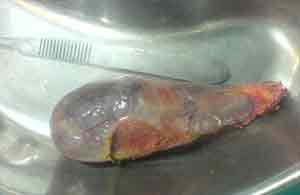Antibiotics After Gall Bladder Surgery Do Not Appear to Reduce Risk of Infection
 Among patients who underwent gall bladder removal for acute calculous cholecystitis, lack of postoperative antibiotic treatment did not result in a
Among patients who underwent gall bladder removal for acute calculous cholecystitis, lack of postoperative antibiotic treatment did not result in a
greater incidence of infections, according to a study in the July 9 issue of JAMA.
Acute calculous cholecystitis is the third most frequent cause of emergency admissions to surgical wards. In the United States, approximately 750,000
cholecystectomies are performed each year and about 20 percent of these operations are due to acute calculous cholecystitis. Many patients receive
postoperative antibiotics with the intent to reduce subsequent infections, although there is limited information from controlled studies demonstrating
benefit, according to background information in the article.
Jean Marc Regimbeau, M.D., Ph.D., of the Amiens University Medical Center, Amiens, France, and colleagues randomly assigned 414 patients with mild or
moderate acute calculous cholecystitis to continue with a preoperative antibiotic regimen (amoxicillin plus clavulanic acid) or receive no antibiotics
after cholecystectomy. The study was conducted at 17 medical centers between May 2010 and August 2012.
The researchers found that the postoperative infection rates were 17 percent in the nontreatment group and 15 percent in the antibiotic group. In a per
protocol analysis involving 338 patients, the corresponding rates were both 13 percent. Based on a noninferiority (not worse than) margin of 11 percent
established for this trial, the lack of postoperative antibiotic treatment was not associated with worse outcomes than antibiotic treatment. The two
groups of patients had similar length of hospital stay and readmission rates.
The authors note that guidelines published by the Infectious Diseases Society of America and the World Society of Emergency Surgery recommend treatment
with amoxicillin plus clavulanic acid or sulbactam after cholecystectomy for noncomplicated acute calculous cholecystitis. “In the present series, we did
not observe a benefit of postoperative antibiotic treatment on infections for patients with [mild or moderate] acute calculous cholecystitis.”
“It is well known that continuation of antibiotic treatment increases costs and promotes the selection of multiresistant bacteria. In 2010, 37,499
cholecystectomies for acute calculous cholecystitis were performed in France, and 90 percent of these were for grades I and II [mild or moderate] acute
calculous cholecystitis. Supposing that these patients did not really need postoperative antibiotics (which are generally prescribed for 5 days), we
estimate that many days of antibiotic treatment could be avoided each year. Reduction of the use of unnecessary antibiotics is important given that there
is an increasing antibiotic resistance and a higher incidence of antibiotic complications such as Clostridium difficile infection. Our study demonstrates
that postoperative antibiotics following acute calculous cholecystitis are not necessary.”
Clinical Trial Evidence to Advance the Science of Cholecystectomy
Joseph S. Solomkin, M.D., of the University of Cincinnati College of Medicine, Cincinnati, writes in an accompanying editorial that the two
cholecystectomy-related trials in this issue provide important new evidence to better inform surgeons performing this procedure; “however, both studies
have a frequently encountered limitation of surgical trials—lack of blinding. In many surgical trials, blinding is not possible, or in some cases, as
with sham procedures, blinding may raise important ethical considerations.”
“Blinding in randomized trials avoids physician and patient perceptions of efficacy from influencing protocol adherence or outcome assessment. Blinding
is usually associated with random treatment assignment, and the treating physician, the patient, and the outcome assessor do not know what intervention
the patient received. Blinding and randomization minimize the risk of conscious and unconscious bias in clinical trials (performance bias) and
interpretation of outcomes (ascertainment bias).”
Dr. Solomkin notes that randomized trials, even if blinding is not possible, contribute greatly to evidence-based recommendations for clinical practice
guidelines. “The clinical trials by Regimbeau et al and Iranmanesh et al provide useful data that help answer important questions about the management of
patients undergoing cholecystectomy.”
Source Newsroom: JAMA – Journal of the American Medical Association

